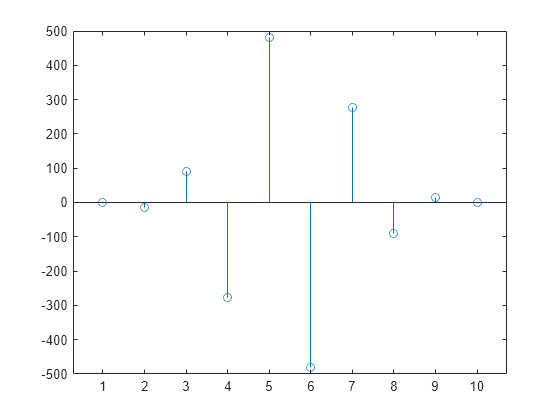Matemáticas de precisión simple
Este ejemplo muestra cómo ejecutar aritmética y álgebra lineal con datos de precisión simple. También muestra cómo los resultados se calculan de forma adecuada en precisión simple o doble precisión, según la entrada.
Crear datos de doble precisión
Creemos primero algunos datos que, de forma predeterminada, son de doble precisión.
Ad = [1 2 0; 2 5 -1; 4 10 -1]
Ad = 3×3
1 2 0
2 5 -1
4 10 -1
Convertir a precisión simple
Se pueden convertir datos a precisión simple con la función single.
A = single(Ad); % or A = cast(Ad,'single');Crear ceros y unos de precisión simple
También se pueden crear ceros y unos de precisión simple con sus respectivas funciones.
n = 1000; Z = zeros(n,1,'single'); O = ones(n,1,'single');
Examinemos las variables en el área de trabajo.
whos A Ad O Z n
Name Size Bytes Class Attributes A 3x3 36 single Ad 3x3 72 double O 1000x1 4000 single Z 1000x1 4000 single n 1x1 8 double
Vemos que algunas de las variables son de tipo single y que la variable A (la versión en precisión simple de Ad) necesita, para su almacenamiento, la mitad de la cantidad de bytes de memoria porque los valores simples requieren únicamente 4 bytes (32 bits), mientras que los valores dobles requieren 8 bytes (64 bits).
Aritmética y álgebra lineal
Se puede ejecutar aritmética estándar y álgebra lineal con valores simples.
B = A' % Matrix TransposeB = 3×3 single matrix
1 2 4
2 5 10
0 -1 -1
whos BName Size Bytes Class Attributes B 3x3 36 single
Vemos que el resultado de esta operación, B, es un valor simple.
C = A * B % Matrix multiplicationC = 3×3 single matrix
5 12 24
12 30 59
24 59 117
C = A .* B % Elementwise arithmeticC = 3×3 single matrix
1 4 0
4 25 -10
0 -10 1
X = inv(A) % Matrix inverseX = 3×3 single matrix
5 2 -2
-2 -1 1
0 -2 1
I = inv(A) * A % Confirm result is identity matrixI = 3×3 single matrix
1 0 0
0 1 0
0 0 1
I = A \ A % Better way to do matrix division than invI = 3×3 single matrix
1 0 0
0 1 0
0 0 1
E = eig(A) % EigenvaluesE = 3×1 single column vector
3.7321
0.2679
1.0000
F = fft(A(:,1)) % FFTF = 3×1 single column vector
7.0000 + 0.0000i
-2.0000 + 1.7321i
-2.0000 - 1.7321i
S = svd(A) % Singular value decompositionS = 3×1 single column vector
12.3171
0.5149
0.1577
P = round(poly(A)) % The characteristic polynomial of a matrixP = 1×4 single row vector
1 -5 5 -1
R = roots(P) % Roots of a polynomialR = 3×1 single column vector
3.7321
1.0000
0.2679
Q = conv(P,P) % Convolve two vectorsQ = 1×7 single row vector
1 -10 35 -52 35 -10 1
R = conv(P,Q)
R = 1×10 single row vector
1 -15 90 -278 480 -480 278 -90 15 -1
stem(R); % Plot the result
Un programa que trabaja tanto en precisión simple como en doble precisión
Veamos ahora una función para calcular suficientes términos en la sucesión de Fibonacci para que la relación sea menor que el épsilon de la máquina correcto (eps) para tipos de datos simples o dobles.
% How many terms needed to get single precision results? fibodemo('single')
ans = 19
% How many terms needed to get double precision results? fibodemo('double')
ans = 41
% Now let's look at the working code. type fibodemo
function nterms = fibodemo(dtype) %FIBODEMO Used by SINGLEMATH demo. % Calculate number of terms in Fibonacci sequence. % Copyright 1984-2014 The MathWorks, Inc. fcurrent = ones(dtype); fnext = fcurrent; goldenMean = (ones(dtype)+sqrt(5))/2; tol = eps(goldenMean); nterms = 2; while abs(fnext/fcurrent - goldenMean) >= tol nterms = nterms + 1; temp = fnext; fnext = fnext + fcurrent; fcurrent = temp; end
Observe que se inicializan varias de las variables, fcurrent, fnext y goldenMean, con valores que dependen del tipo de datos de entrada, y que la tolerancia tol depende también de ese tipo. La precisión simple requiere que se calculen menos términos que en el cálculo equivalente de doble precisión.